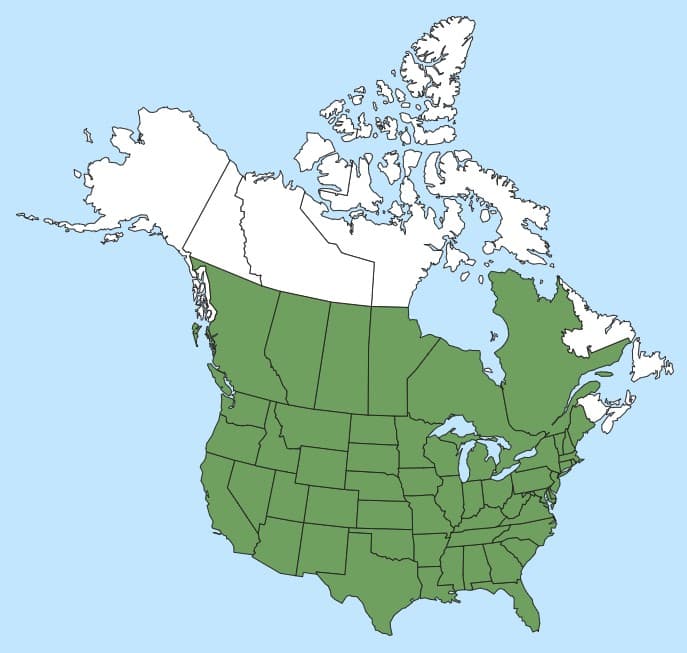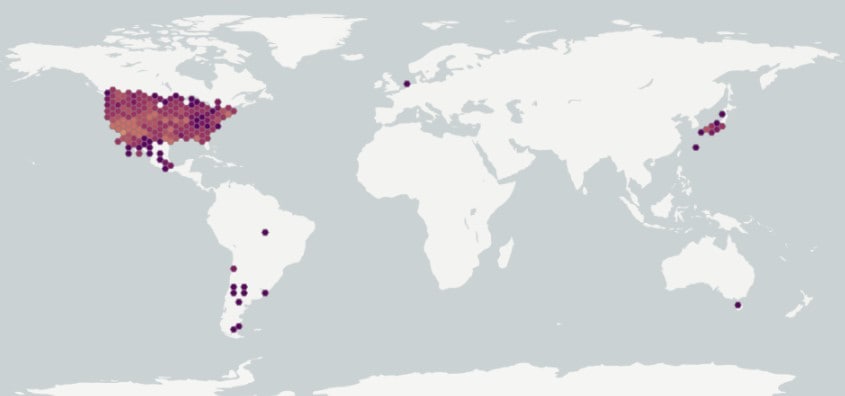Festuca octoflora
Explore More :
Explore plus :
Overview
Aperçu
Regulation :
Remarques Réglementation:
Regulation Notes:
Distribution :
Répartition :
Festuca octoflora is native to North America, from the provinces of British Columbia eastward to Québec, south throughout the United States, and into Mexico. (Cronquist et al. 1977; Wiersema and León 1999; Barkworth et al. 2007; USDA-ARS 2023; USDA-NRCS 2023). The species has been introduced into temperate regions of South America, Europe, and Asia (Lonard and Gould 1974).
Habitat and Crop Association :
Habitat et Cultures Associées :
Festuca octoflora is a widespread native species in North America found in grasslands, desert shrub, sagebrush, open woodlands and disturbed areas (Howard 2006; Barkworth et al. 2007).
Economic Use, cultivation area, and Weed Association :
Utilisation économique, zone de culture et association de mauvaises herbes :
Festuca octoflora is used for erosion control (Wiersema and León 1999; USDA-ARS 2023).
Bromus rubens (red brome), B. secalinus (cheatgrass), and other exotic annuals may out compete and displace F. octoflora in its native range (Howard 2006).
Duration of Life Cycle :
Durée du cycle vital:
Annual
Dispersal Unit Type :
Type d’unité de dispersion :
Floret
General Information
RENSEIGNEMENTS GÉNÉRAUX
Festuca octoflora is a tufted, annual, cool-season grass species native to North America. Seeds of F. octoflora are marketed for reclamation purposes (GSC 2023). Except for during the short growth period in early spring, F. octoflora has little forage value for livestock or large wild herbivores, such as elk, mule deer, and pronghorn (Stubbendieck et al. 1982; Howard 2006). Black-tailed jackrabbits, black-tailed and white-tailed prairie dogs graze on F. octoflora (Howard 2006). Seeds of F. octoflora are consumed by plains pocket gophers, Merriam’s kangaroo rats, Arizona, Bailey’s and rock pocket mice, Townsend ground squirrels, chukars, sharp-tailed grouse, lesser prairie-chickens, and granivorous songbirds (Howard 2006).
The species has been divided into at least three subtaxa by some authors with subtaxa characterization based on lengths of spikelets and awns, and types of hairs on the lemmas (Lonard and Gould 1974; Cronquist et al. 1977; Diggs Jr. et al. 2006; Barkworth et al. 2007). In this factsheet no attempt is made to distinguish subtaxa.
Note: Some authors separate the genus Vulpia from Festuca because this group of plants usually have an annual life cycle duration, a single stamen per flower, and the tendency for self-pollination (cleistogamous); whereas, Festuca plants usually have a perennial life cycle duration, three stamens per flower, and are open-pollinated (chasmogamous). Plants traditionally assigned to the genus Vulpia have also been placed under the genus Festuca by some authors and are currently treated under this genus in the GRIN database and by the AOSA Rules (AOSA 2022; USDA-ARS 2023).
.Identification
Identification
-
Spikelet
Size
- Spikelet length: 4 – 10 (13) mm excluding the awns (Lonard and Gould 1974; Diggs Jr. et al. 2006; Barkworth et al. 2007).
Spikelet size measurements from the literature:
• Spikelet length: 4 – 10 mm excluding the awns (Lonard and Gould 1974).
• Spikelet length: 4 – 10 mm (Diggs Jr. 2006).
• Spikelet length: 4 – 10 (13) mm (Barkworth et al. 2007).Shape
- Spikelet shape oval to oblong, laterally compressed (Barkworth et al. 2007).
Surface Texture
- Spikelet surface texture smooth to hairy (Lonard and Gould 1974).
Colour
- Spikelets green or light yellowish brown coloured at maturity (Lonard and Gould 1974).
Other Features
Spikelet composition
- Spikelet composed of (4) 5 – 11 (17) similar looking florets, distal florets usually reduced in size and staminate or sterile (Barkworth et al. 2007).
Glumes
- Lower glume 1.7 – 4.5 mm, one-half to two-thirds as long as upper glume; upper glume length: 2.5 – 7.2 mm (Barkworth et al. 2007).
Spikelet disarticulation
- Disarticulation of the spikelet occurs generally above the glumes and between the florets at the rachilla nodes.
-
Floret
Size
- Floret length*: 2.5 – 4.7 mm (average 3.7 mm); width*: 0.5 – 0.8 mm (average 0.6 mm)
- Awn length*: 0.6 – 2.8 mm (average 1.5 mm)
- Rachilla length*: 0.4 – 0.7 mm (average 0.5 mm)
*Note: minimum and maximum based on a random selection of 20 florets in normal range of this species using image measurement protocol (ISMA 2020). CDA-S-57407.
Floret size measurements from the literature:
• Lemma length 2.7 – 6.5 mm; awn length 0.3 – 6.0 (9.0) mm; rachilla length 0.5 – 0.7 mm (Lonard and Gould 1974).
• Lemma length 3 – 5 (6.5) mm; awn length 1.5 – 4 (5) mm (Cronquist et al. 1977).
• Lemma length 2.5 – 6.5 mm; awn length 0.3 – 9 mm (Diggs Jr. et al. 2006).
• Lemma length 2.7 – 6.5 mm; awn length 0.3 – 9 mm (Barkworkth et al. 2007).Shape
- Floret tear-drop shaped, dorsal-ventrally compressed and edges in-rolled.
Surface Texture
- Lemma and palea papery.
Colour
- Pale yellowish-brown coloured.
Other Features
Lemma
- Lemma tapered and extending into an awn.
- Lemma generally wraps around and covers the margins of the palea but usually leaving the palea keels exposed.
- Lemma 5-nerved.
- Lemma smooth or covered with short stiff hairs or longer soft hairs. Note that hairiness often varies on spikelets of the same plant and even on different lemmas of the same spikelet (Lonard and Gould 1974).
Awn
- Awn short and straight.
- Awn covered with short stiff hairs.
Callus
- Callus a blunt, narrow ridge.
- Callus glabrous in center and with short hairs at outer edges.
Rachilla
- Rachilla thin cylindrical with flared disk at tip.
- Rachilla covered with short stiff hairs.
Palea
- Palea opaque to semi-transparent with caryopsis somewhat visible through palea.
- Palea nearly equal to lemma length.
- Palea grainy textured or sparsely covered with hairs between keels.
- Palea keel hairs (palea teeth) long and evenly spaced.
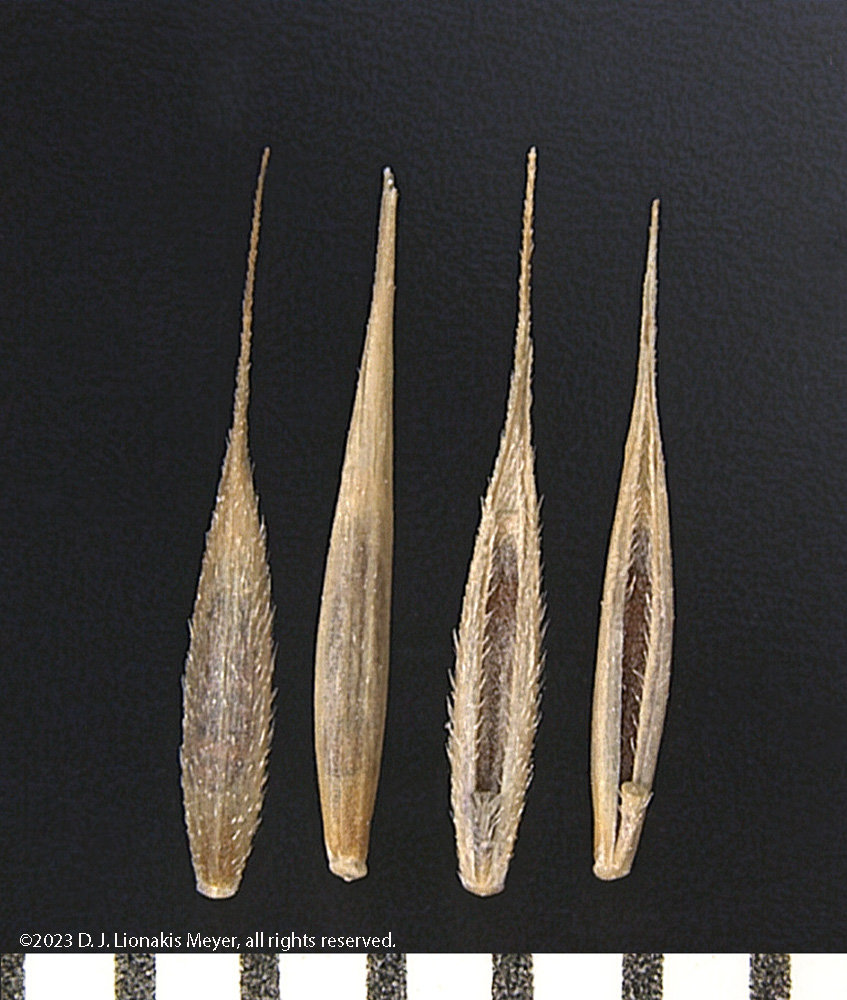
Festuca octoflora (six-weeks fescue) florets group. [synonym Vulpia octoflora] Scale in mm

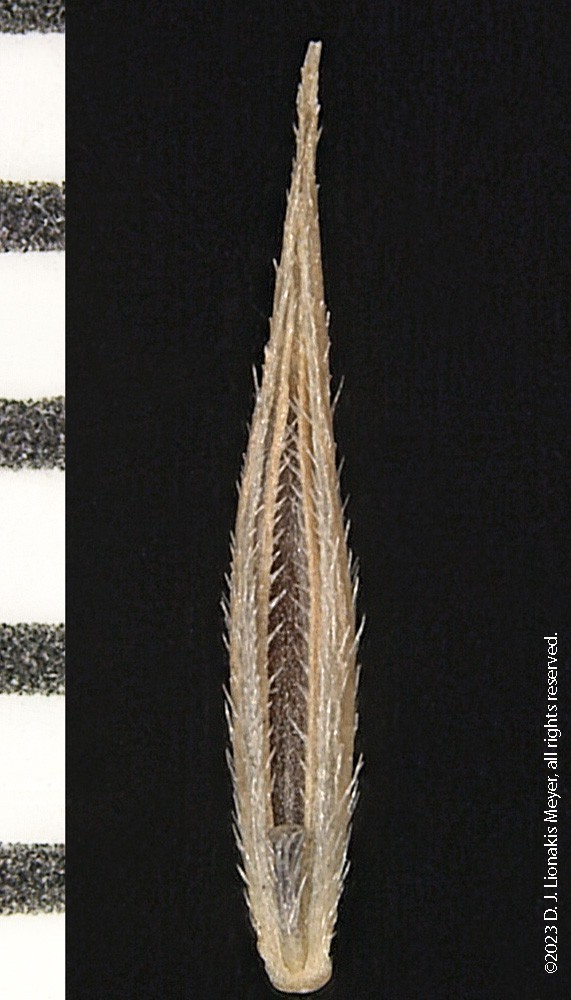
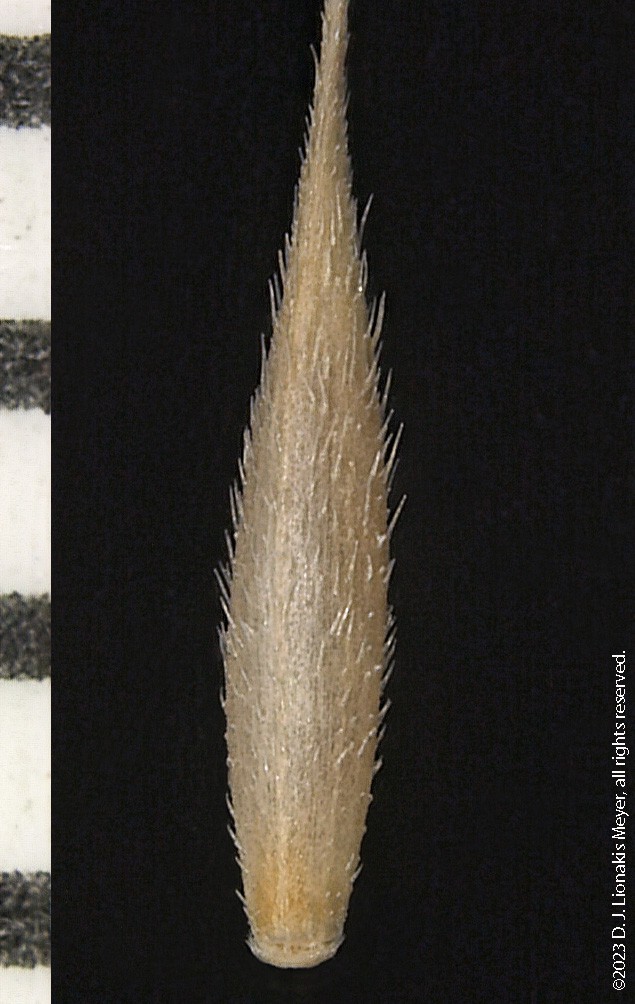
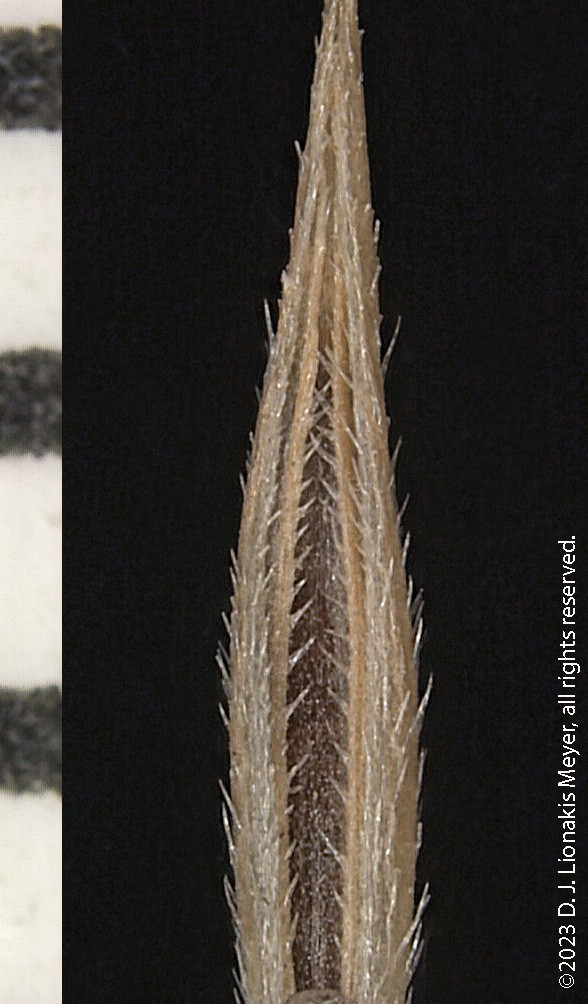
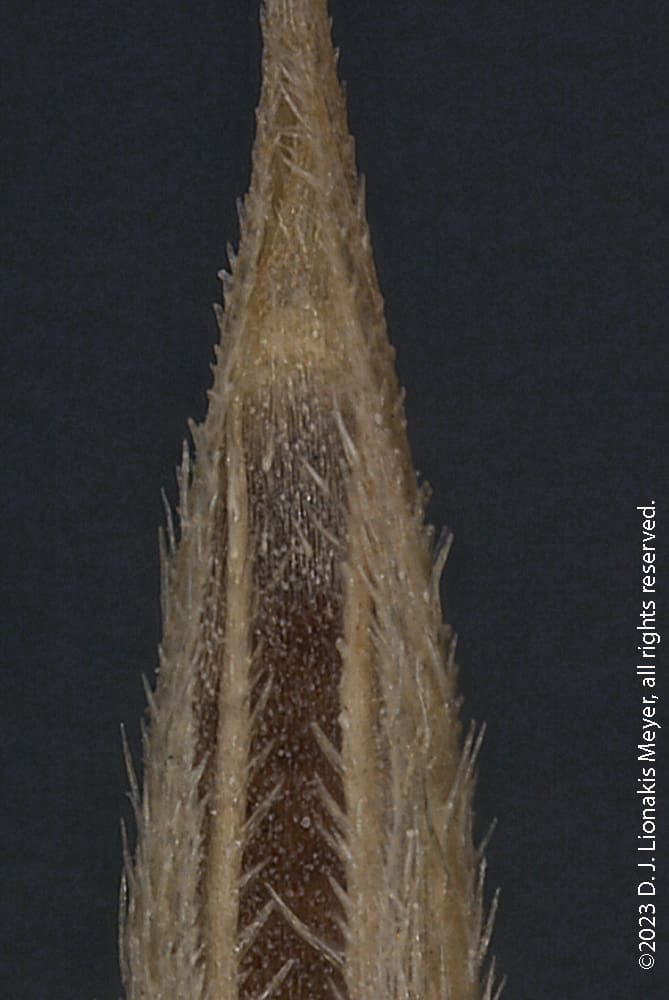
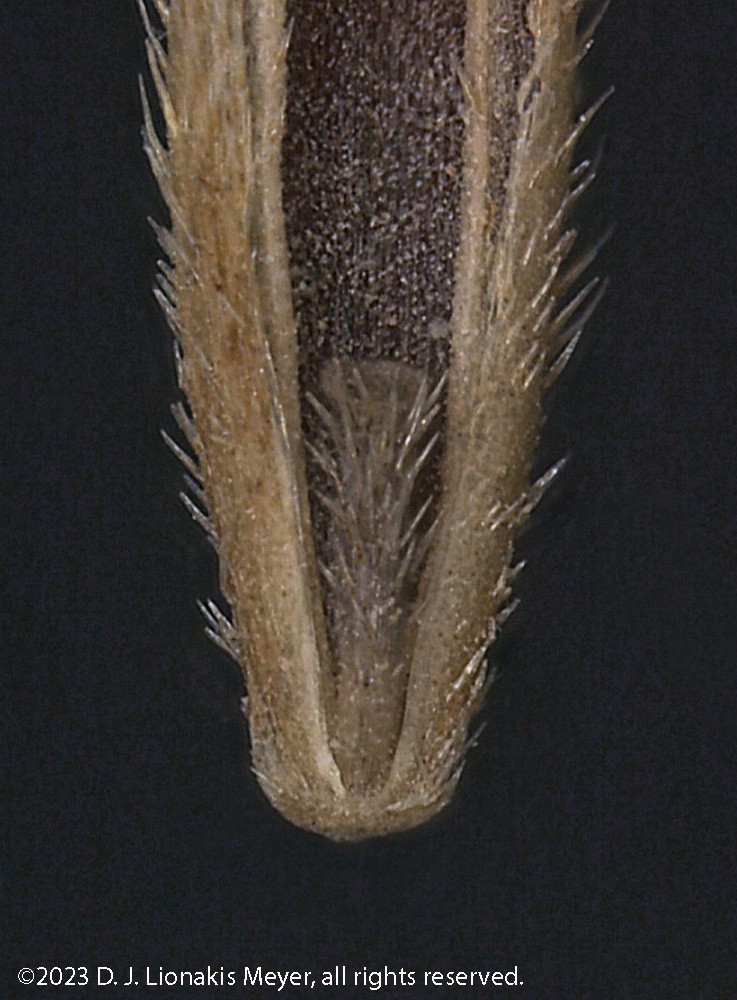
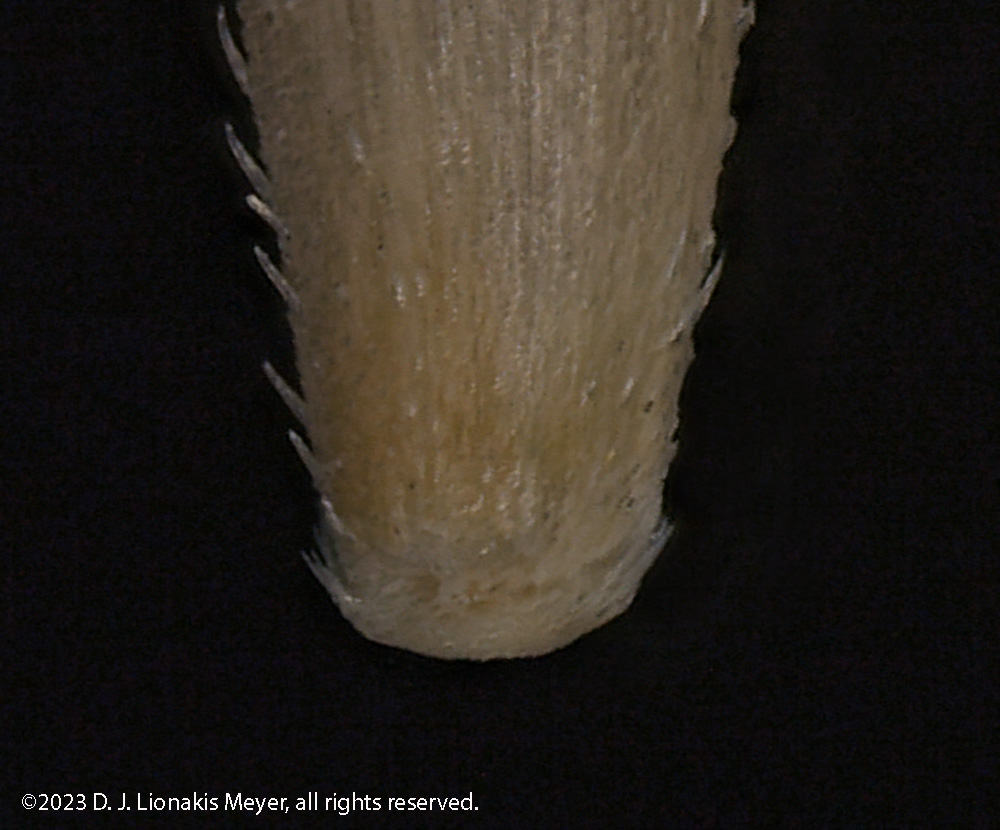
-
Caryopsis
Size
- Caryopsis length*: 2.1 – 2.7 mm (average 2.3 mm); width*: 0.5 – 0.7 mm (0.6 mm).
- Hilum length*: 1.0 – 1.6 mm (average 1.3 mm).
*Note: minimum and maximum based on a random selection of 10 caryopses in normal range of this species using image measurement protocol (ISMA 2020). CDA-S-57407.
Caryopsis size measurements from the literature:
• Caryopsis length: 1.7 – 3.3 mm (Lonard and Gould 1974; Cronquist et al. 1997).
• Caryopsis length: 1.7 – 3.7 mm (Barkworth et al. 2007).
• Caryopsis length: 2 – 3.5 mm (Baldwin et al. 2012).Shape
- Caryopsis oblong to oblong-oval, pointed at embryo end.
Surface Texture
- Surface texture smooth, dull.
- The lemma and palea may adhere to the mature caryopsis.
Colour
- Caryopsis is reddish-brown coloured.
Other Features
- Hilum linear, slightly more than one-half the length of the caryopsis, located in a longitudinal depression.
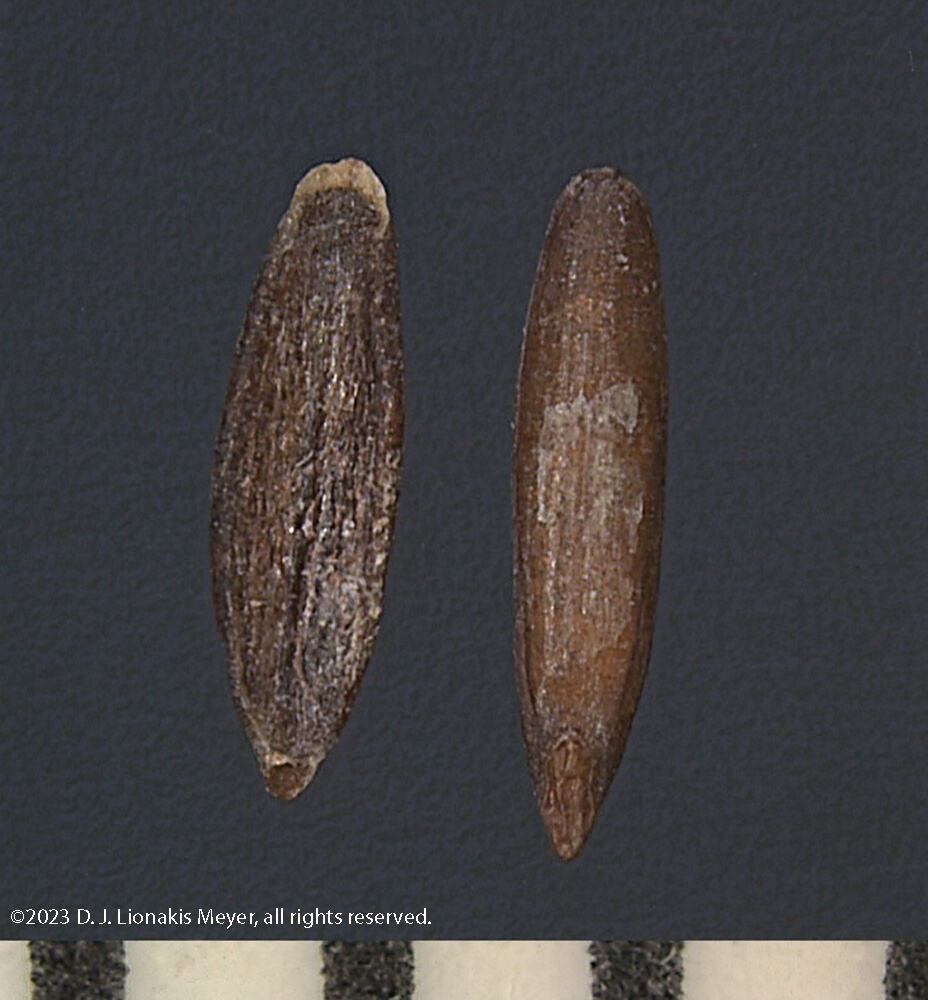
Festuca octoflora (six-weeks fescue) caryopses; hilum view on left and embryo view on right. [Synonym Vulpia octoflora] Scale in mm

-
Embryo
Size
- Embryo length*: 0.4 – 0.5 mm (average 0.4 mm).
- Embryo is about one-sixth the length of the caryopsis.
*Note: minimum and maximum based on a random selection of 10 embryos in normal range of this species using image measurement protocol (ISMA 2020). CDA-S-57407.
Shape
- Embryo shape oval to teardrop shaped.
Endosperm
- Endosperm solid (Terrell 1971).
Other Features
- Embryo in lateral position (Martin 1946).

Festuca octoflora (six-weeks fescue) caryopses; hilum view on left and embryo view on right. [Synonym Vulpia octoflora] Scale in mm

Identification Tips
CONSEILS POUR L’IDENTIFICATION
In seed testing, the three most commonly encountered annual species of Festuca are F. octoflora, F. bromoides, and F. myuros. A few key differences between F. octoflora and F. bromoides or F. myuros include:
- Florets of Festuca octoflora are smaller in size than those of F. bromoides or F. myuros.
- The florets of F. octoflora is narrowly teardrop shaped, while the florets of F. bromoides and F. myuros are long and narrow.
- Palea keel hairs of F. octoflora are longer and spaced further apart than those of F. bromoides or F. myuros.
Refer to the comparison chart under the similar species section of this factsheet for detailed diagnostic features of these three species.

Festuca octoflora (six-weeks fescue) floret in palea view. [Synonym Vulpia octoflora] Scale in mm







Additional Botany Information
AUTRES RENSEIGNEMENTS BOTANIQUES
Flowers/Inflorescence
- The inflorescence of Festuca octoflora is usually an upright or slightly drooping, dense, and narrow panicle, of various lengths ranging from 1 – 7 cm long to as much as 20 cm long and 0.5 – 1.5 cm wide (Diggs Jr. et al. 2006; Barkworth et al. 2007; Baldwin et al. 2012).
- The plants are usually self-pollinated (Cronquist et al. 1997; Barkworth et al. 2007).
Vegetative Features
- The stems of Festuca octoflora are slender, upright or lying on the ground, 5– 60 cm tall, solitary or loosely tufted (Lonard and Gould 1974; Barkworth et al. 2007).
Similar Species
ESPÈCES SEMBLABLES
Similar species are based on a study of seed morphology of various species, and those with similar dispersal units are identified. The study is limited by physical specimen and literature availability at the time of examination, and possibly impacted by the subjectivity of the authors based on their knowledge and experience. Providing similar species information for seed identification is to make users aware of similarities that could possibly result in misidentification.
Two other species of Festuca that are native to North America may occasionally be encountered in seed samples of F. octoflora; Festuca microstachys, native to western North America from British Columbia to Baja California, and Festuca sciurea, native to the southeastern region of the United States (Barkworth et al. 2007; USDA-NRCS 2023). Depending on the botanical variety, florets of F. microstachys may be covered with hairs of various lengths or smooth (without hairs) similar to florets of F. octoflora; however, florets of F. microstachys are usually larger in size (3.5 – 9.5 mm long) than those of F. octoflora (Barkworth et al. 2007). Festuca sciurea is generally smaller in size (lemma 2.5 – 3.5 mm; 3-nerved) compared to F. octoflora (2.7 – 6.5 mm; 5-nerved) and the hairs near the lemma tip are much longer than those of F. octoflora (Barkworth et al. 2007).
Festuca octoflora is marketed for erosion control (UDA-ARS 2023) and reclamation (GSC 2023). Florets of F. octoflora are generally smaller in size compared to weedy species F. bromoides or F. myuros and have much shorter awns. Festuca bromoides and F. myuros may be found as contaminants in seed lots of F. octoflora. Refer to the comparison table for detailed diagnostic features of these three species.
Comparison table for mature floret and glume characters for Festuca octoflora, F. bromoides, and F. myuros. Measurements* shown are by author using ISMA measurement protocol (2020).
| F. octoflora | F. bromoides | F. myuros | |
| Floret shape | Narrowly teardrop-shaped (lanceolate); body straight in lateral view | Narrowly linear-teardrop shaped (narrowly lanceolate); body straight or arched backward in lateral view | Linear; body straight in lateral view |
| Floret length* | 2.5 – 4.7 mm (average 3.7 mm) | 4.1 – 7.7 mm (average 5.9 mm) | 5.5 – 6.9 mm (average 6.4 mm) |
| Floret width*
|
0.5 – 0.8 mm (average 0.6 mm) | 0.4 – 0.8 mm (average 0.6 mm) | 0.4 – 0.7 mm (average 0.5 mm) |
| Lemma surface texture and hairs | Depending on variety, smooth or covered with short stiff or longer soft hairs | Mostly smooth in lower one-third and covered with short stiff hairs in upper one-third to two-thirds | Mostly smooth to covered with short stiff hairs |
| Lemma awn length* | 0.6 – 2.8 mm (1.5 mm) | 2.8 – 13.3 mm (average 6.1 mm) | 5.0 – 13.1 mm (average 10.6 mm) |
| Callus | Blunt, narrow ridge, smooth in center and with short hairs at outer edges | Smooth, without hairs, narrow at outer edges and thicker in center, looking like a gently rounded point | Smooth, without hairs, narrow at outer edges and thicker in center, looking like a gently rounded point |
| Palea | Opaque to semi-transparent, grainy textured or sparsely covered with hairs between keels | Palea tip usually flattened out; semi-transparent with caryopsis visible through palea; palea may be in-rolled concealing view of caryopsis; sparsely covered with short hairs between keels | Nearly transparent with caryopsis visible through palea; slightly grainy textured between keels |
| Palea keel hairs (teeth) | Evenly spaced, short and stiff with broad base tapering to a point. | Evenly spaced, short and stiff with broad base tapering to a point, hairs are longer near palea tip | Evenly spaced, short and stiff with broad base tapering to a point, hairs are same length all the way to the palea tip |
| Caryopsis size* | 2.1 – 2.7 mm long; 0.5 – 0.7 mm wide | 2.6 – 4.8 mm long; 0.7 – 1.1 mm wide | 3.2 – 4.5 mm long; 0.5 – 0.6 mm wide |
| Hilum* | Linear; slightly more than one-half the length of the caryopsis | Linear; about nine-tenths the length of the caryopsis | Linear; about three-quarters the length of the caryopsis |
Click to select species
Cliquez pour sélectionner les espèces
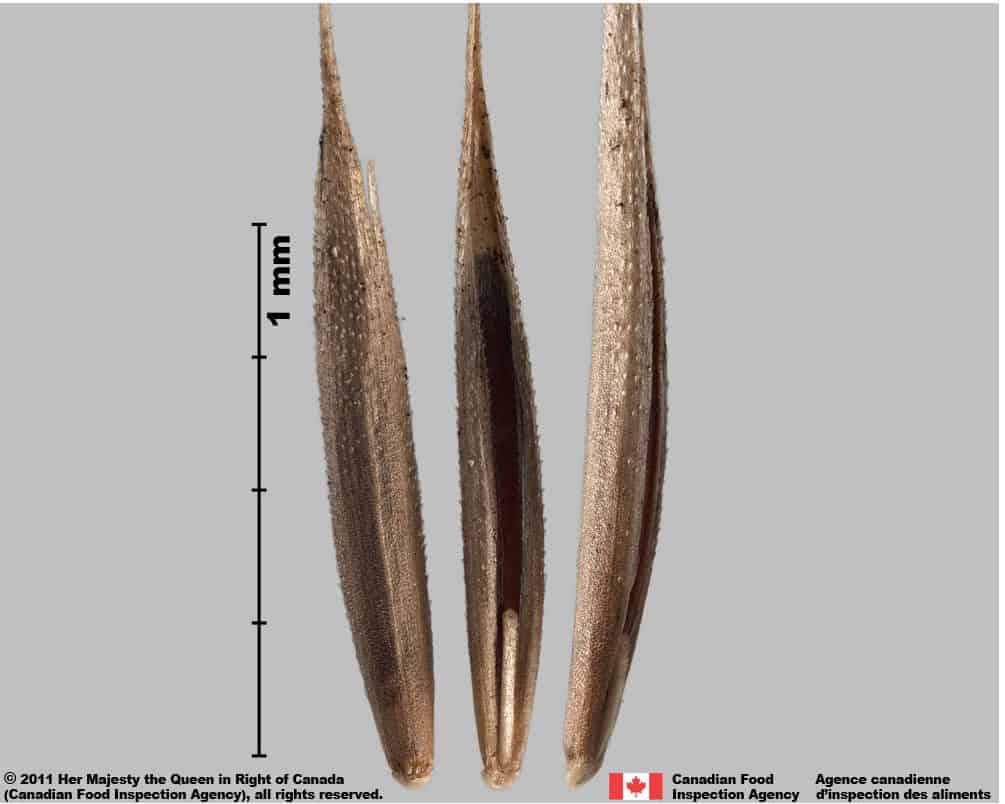
Festuca bromoides
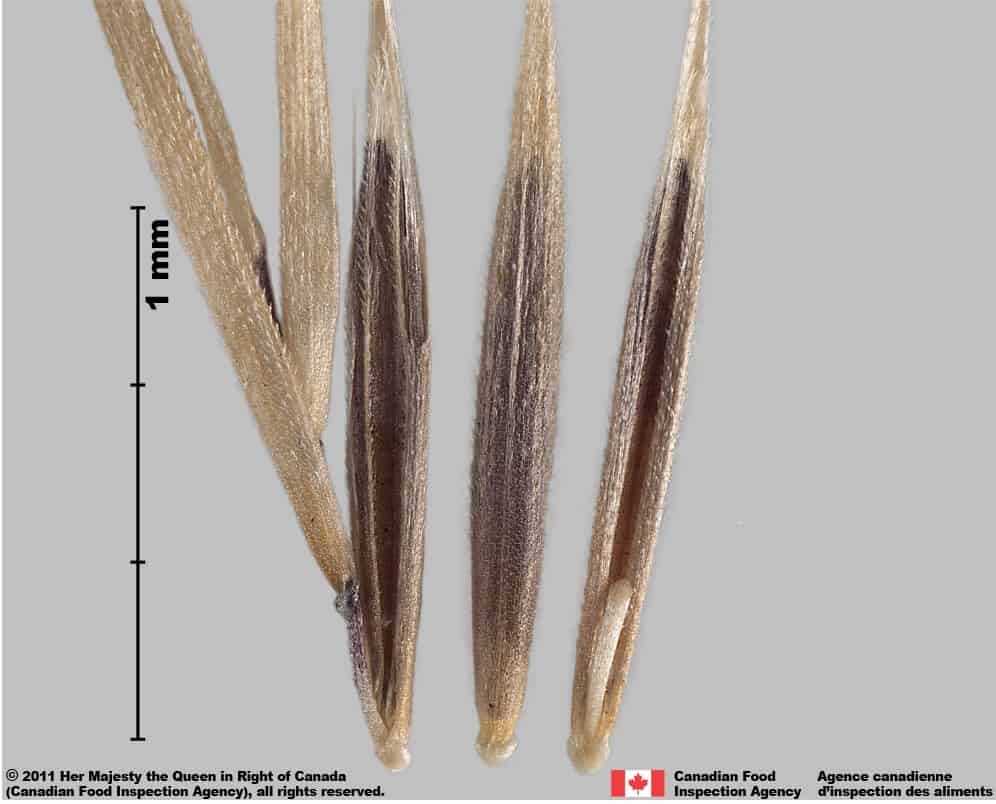
Festuca myuros
Comparison Window
Fenêtre de comparaison
MAIN SPECIES
ESPÈCES PRINCIPALES
Festuca octoflora

Festuca octoflora
Poaceae
Festuca octoflora (six-weeks fescue) florets group. [synonym Vulpia octoflora] Scale in mm
MAIN SPECIES
ESPÈCES PRINCIPALES
Festuca octoflora

Festuca octoflora
Poaceae
Festuca octoflora (six-weeks fescue) floret in palea view. [Synonym Vulpia octoflora] Scale in mm
MAIN SPECIES
ESPÈCES PRINCIPALES
Festuca octoflora

Festuca octoflora
Poaceae
Festuca octoflora (six-weeks fescue) floret in lemma view. Scale in mm
MAIN SPECIES
ESPÈCES PRINCIPALES
Festuca octoflora

Festuca octoflora
Poaceae
Festuca octoflora (six-weeks fescue) palea keels with long, widely spaced hairs (palea teeth). [Synonym Vulpia octoflora] Scale in mm
MAIN SPECIES
ESPÈCES PRINCIPALES
Festuca octoflora

Festuca octoflora
Poaceae
Festuca octoflora (six-weeks fescue) palea granular in texture and with hairs between the keels near the tip. [Synonym Vulpia octoflora]
MAIN SPECIES
ESPÈCES PRINCIPALES
Festuca octoflora

Festuca octoflora
Poaceae
Festuca octoflora (six-weeks fescue) close-up of rachilla covered with long hairs. [Synonym Vulpia octoflora]
MAIN SPECIES
ESPÈCES PRINCIPALES
Festuca octoflora

Festuca octoflora
Poaceae
Festuca octoflora (six-weeks fescue) floret callus with short hairs at outer edges. [Synonym Vulpia octoflora]
MAIN SPECIES
ESPÈCES PRINCIPALES
Festuca octoflora

Festuca octoflora
Poaceae
Festuca octoflora (six-weeks fescue) caryopses; hilum view on left and embryo view on right. [Synonym Vulpia octoflora] Scale in mm
SIMILAR SPECIES
ESPÈCES SEMBLABLES
Festuca bromoides

Festuca bromoides
Poaceae
Festuca bromoides (brome fescue) florets
SIMILAR SPECIES
ESPÈCES SEMBLABLES
Festuca bromoides
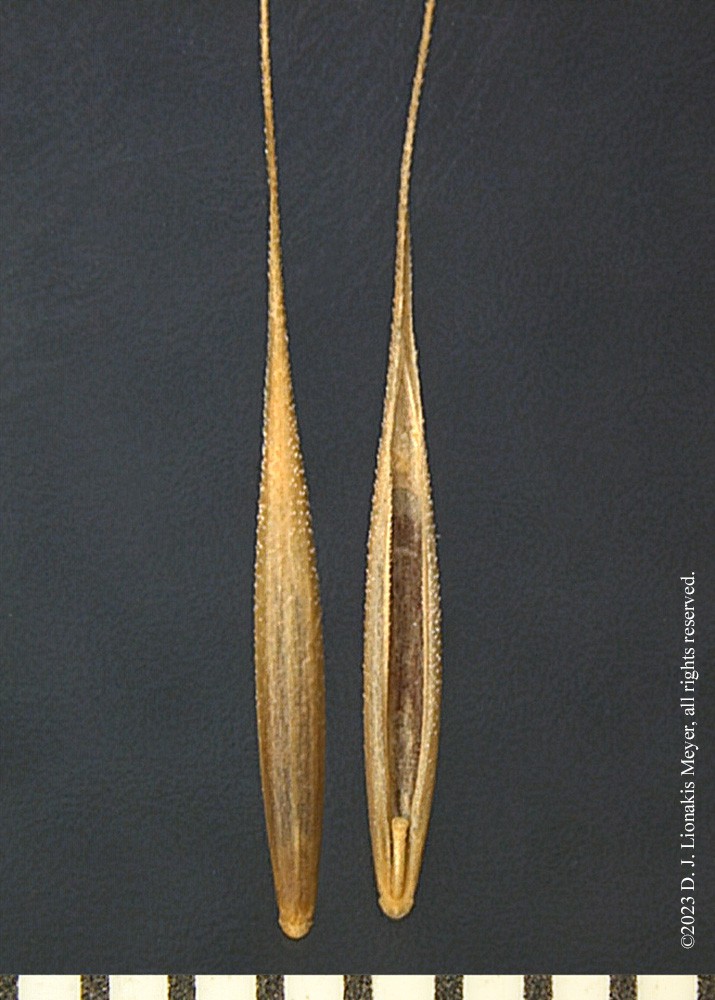
Festuca bromoides
Poaceae
Festuca bromoides (brome fescue) florets, lemma view (left) and palea view (right). [Vulpia bromoides] Scale in mm
SIMILAR SPECIES
ESPÈCES SEMBLABLES
Festuca bromoides
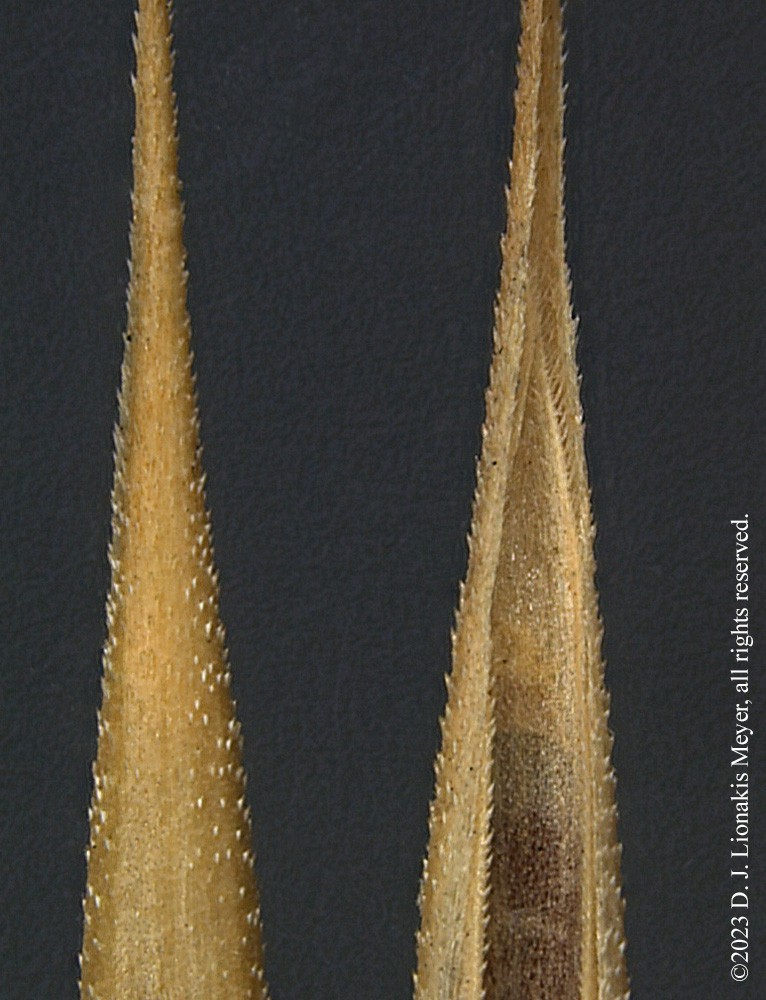
Festuca bromoides
Poaceae
Festuca bromoides (brome fescue) close-up view of florets showing surface texture detail. Lemma tip and base of awn (left) covered with short stiff hairs. Palea view (right) showing short stiff hairs (palea teeth) along the palea keels transitioning into longer and more closely spaced hairs near palea tip. [Vulpia bromoides]
SIMILAR SPECIES
ESPÈCES SEMBLABLES
Festuca bromoides
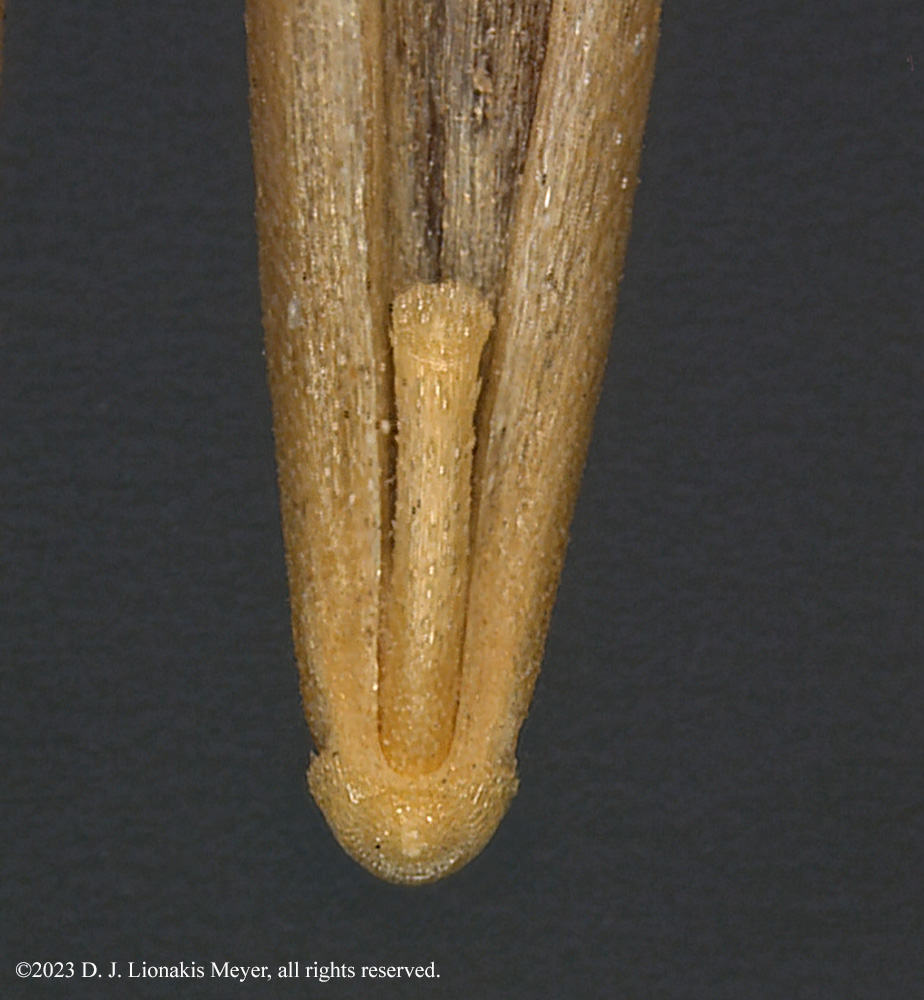
Festuca bromoides
Poaceae
Festuca bromoides (brome fescue) rachilla is thin and cylindrical and covered with short stiff hairs. [Vulpia bromoides]
SIMILAR SPECIES
ESPÈCES SEMBLABLES
Festuca bromoides
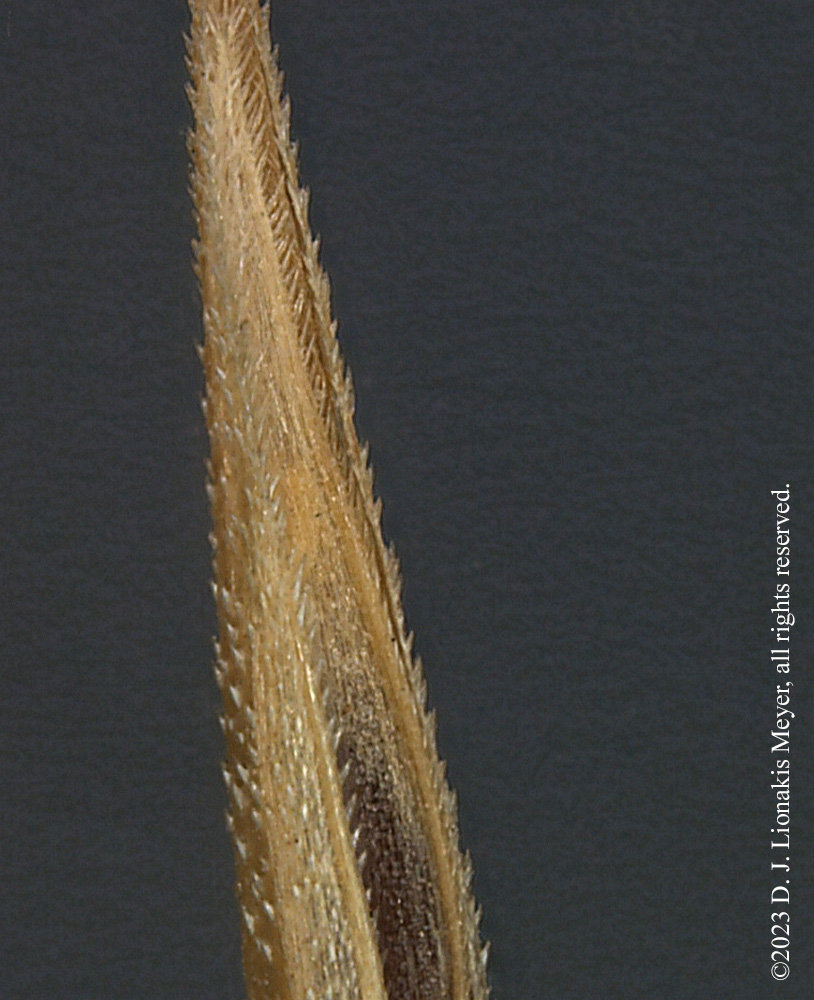
Festuca bromoides
Poaceae
Festuca bromoides (brome fescue) close-up view of palea showing short stiff hairs (palea teeth) along the exposed palea keels transitioning into longer and more closely spaced hairs near palea tip. [Vulpia bromoides]
SIMILAR SPECIES
ESPÈCES SEMBLABLES
Festuca bromoides
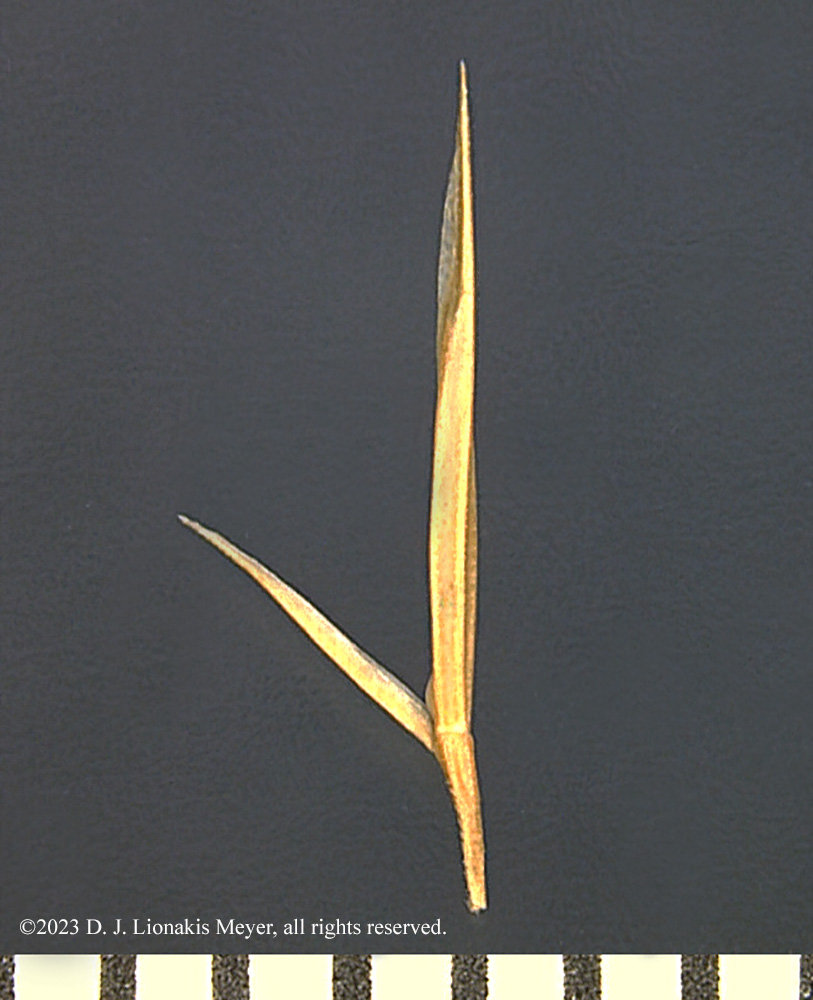
Festuca bromoides
Poaceae
Festuca bromoides (brome fescue) glumes and attached pedicel; in this species the lower glume is one-half or more the length of the upper glume. [Vulpia bromoides] Scale in mm
SIMILAR SPECIES
ESPÈCES SEMBLABLES
Festuca bromoides
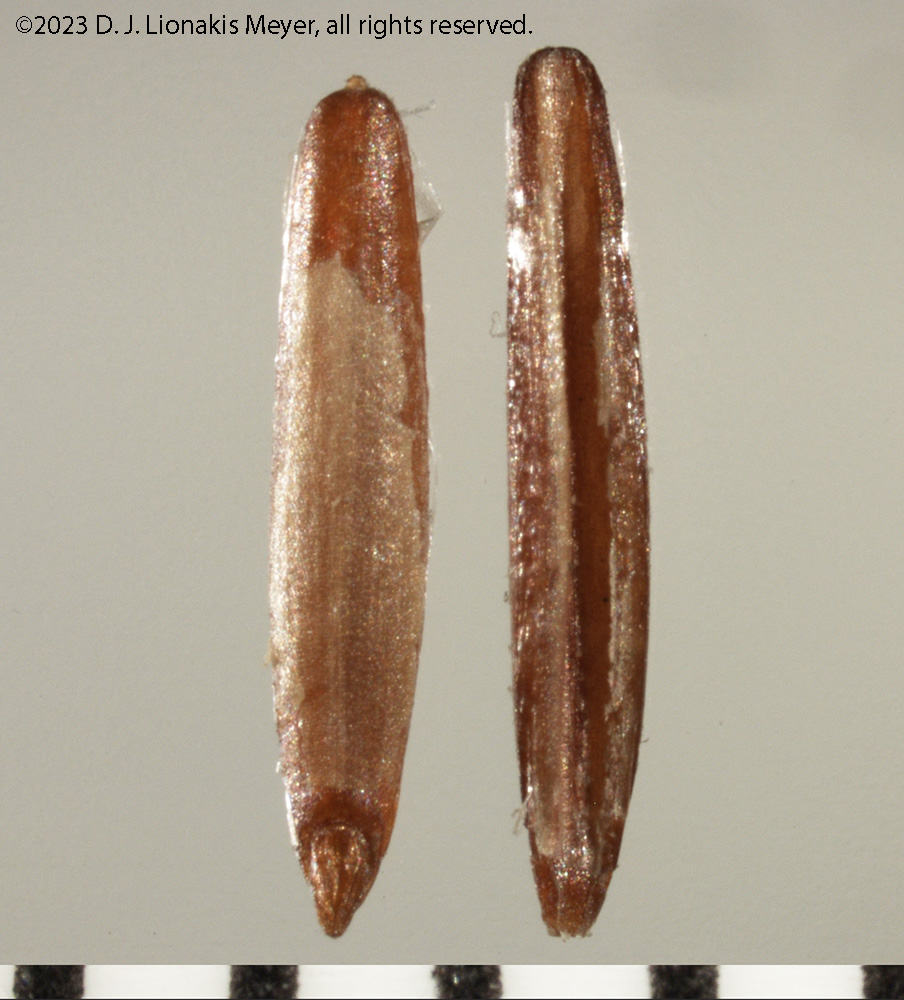
Festuca bromoides
Poaceae
Festuca bromoides (brome fescue) caryopses, embryo view (left) and hilum view (right). [Vulpia bromoides] Scale in mm
Need ID Help?
Besoin d’aide pour l’identification?
Reference(s)
Référence(s)
Association of Official Seed Analysts (AOSA). 2022. Rules for Testing Seeds. Volume 3: Uniform Classification of Weed and Crop Seeds. Association of Official Seed Analysts, Washington DC.
Baldwin, B. G., Goldman, D. H., Keil, D. J., Patterson, R., Rosatti, T. J., Wilken, D. H. (Eds.). 2012. The Jepson Manual: Vascular Plants of California. 2nd edition. University of California Press, Berkeley, CA.
Barkworth, M. E., Capels, K. M., Long, S., and Piep, M. B. (eds.). 2007. Flora of North America Volume 24. Magnoliophyta: Commelinidae (in part): Poaceae, part 1. Oxford University Press, New York, New York.
Cronquist, A., Holmgren, A. H., Homgren, N. H., Reveal, J. L., Homgren P. K. 1977. Intermountain Flora: Vascular Plants of the Intermountain West, U.S.A. Vol. 6: The Monocotyledons. Columbia University Press.
Diggs, Jr., G. M., Lipscomb, B. L., Reed, M. D., O’Kennon, R. J. 2006. Illustrated Flora of East Texas. Volume 1: Introduction, Pteridophytes, Gymnosperms, and Monocotyledons. Botanical Research Institute of Texas, Fort Worth, TX.
Granite Seed Company (GSC). 2023. https://graniteseed.com/seed/grass-species/vulpia-octoflora/ Accessed August 31, 2023.
Howard, J. L. 2006. Vulpia octoflora. In: Fire Effects Information System, [Online]. U.S. Department of Agriculture, Forest Service, Rocky Mountain Research Station, Fire Sciences Laboratory (Producer). Available: https://www.fs.usda.gov/database/feis/plants/graminoid/vuloct/all.html Accessed August 31, 2023.
International Seed Morphology Association (ISMA). 2020. Method for seed size measurement. Version 1.0. ISMA Publication Guide. https://www.idseed.org/authors/details/method_for_seed_size_measurement.html.
Lonard, R. I. and Gould, F. W. 1974. The North American species of Vulpia (Gramineae). Madroño 22:217-230.
Martin, A. C. 1946. The comparative internal morphology of seeds. The American Midland Naturalist 36(3):513-660.
Stubbendieck, J., Hatch, S. L., and Kjar, K. J. 1982. North American Range Plants. 2nd Edition. University of Nebraska Press.
Terrell, E. E. 1971. Survey of occurrences of liquid or soft endosperm in grass genera. Bull. Torr. Botan. Club 98(5):264-268.
United States Department of Agriculture-Agricultural Research Services (USDA-ARS). 2023. Germplasm Resources Information Network (GRIN). http://npgsweb.ars-grin.gov/gringlobal/taxon/taxonomydetail?id=41940. Accessed 10 January 2023.
United States Department of Agriculture-Natural Resources Conservation Service (USDA-NRCS). 2023. The PLANTS Database. National Plant Data Team, Greensboro, NC USA. http://plants.usda.gov Accessed 30 January 2023.
Wiersema, J. H. and León, B. 1999. World Economic Plants: A Standard Reference. CRC Press, Boca Raton, FL.



